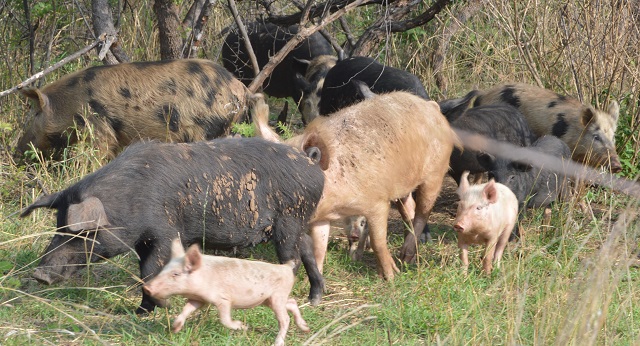
The Sunday News

Dumisani Nsingo, Senior Farming Reporter
ONE of the country’s biggest goat breeders, Mr Chris Grant has embarked on a project aimed at curbing the imminent extinction of an indigenous free range pig breed, Mukota.
The enterprising Matabeleland farmer runs the Mzilikazi Kalahari Red Goat Studs from his two leased farms in Matabeleland North and South Provinces.
Mr Grant started breeding the Mukota pig breed in February as part of his efforts to save them from extinction largely due to their unpopularity which culminates from their low kidding rate.
“They (Mukota pigs) are disease resistant, very hardy, give piglets twice year. They only give six to eight piglets and people say that’s a disadvantage but I disagree because they eat grass.
“You don’t need to spend a lot of money supplementing them. They are free range and feed on forage in the bush and only need six litres of water a day. They don’t get sun burnt like the European breeds,” said Mr Grant.
Mukotas are found primarily in Zimbabwe (with an estimated 70 000 pigs), but also in Mozambique and Zambia. They are believed to have been introduced in the 17th century Europe and China trade (Bonsma and Joubert, 1952), and are named after the Mukota region of northeastern Zimbabwe, where they were first studied in detail.
Mr Grant said over the years farmers have tried to come up with a cross bred of the Mukota and the exotic breeds in an effort to improve on fertility but the efforts have not yielded much success.
“What happened is people wanted the Mukotas for their hardness but wanted the production from the European breeds. So they crossed Mukotas and the European breeds, so they could get the production. But in my view I don’t think that’s correct because if you use the Mukota in its correct application, like free ranging you cannot improve on that animal and studies have been done and it has been proved that it’s correct.
“To me if you have an animal that’s costing you less in food, less in medicine it has to be better than an animal that is locked up in a small enclosure that you have to go and buy 50 kg (kilogrammes) of food to give it, when with these (Mukotas) animals you actually don’t give them anything beside a small supplement to keep them around the house,” he said.
A Mukota carcass yield is about 30 percent less than from the exotic Large White pig, but is considered tasty and “sweet”.
“People talk about the Mukotas having sweet meat and less fat than a commercial produced pig…,” said Mr Grant.
Zimbabwe’s indigenous Mukota pigs are known to be less prone than imported varieties to internal parasites within commercial agriculture.
Mr Grant said rearing of small stock such as chickens, goats, sheep and pigs had a number of comparative advantages in terms of food conversion and disease control compared to keeping cattle.
“Small stocks are easier and cheaper to look after. They breed more and much faster than cattle. Cattle need large areas compared to small stock. Another advantage, if you got 30 goats and you run out of water you can go with a bucket and collect 20 litres of water and those goats will drink less than a litre each of water. If you got 30 cattle or even five and you need water you need 20 litres per animal,” he said.
Mr Grant also breeds pure Matabele, Kalahari Red and Boer goats comprising of 650 does and eight bucks and intends to increase his flock to 1 200 does.
“We have got the Matabele, Kalahari Red and a fewer Boer goat breeds. We are concentrating on the Matabele and Kalahari breed, as a cross breeds it’s probably the best goat around. They have got resistance to diseases again the Kalahari is a long goat so it can reach as high as 1,5 metres in terms of drought when there is no food around it can reach higher than most other goats. They (Kalahari) are very fertile, if your management is correct from the time of birth to the time of slaughter it can be anything between 12 to 15 months,” he said.
Mr Grant said the country had the potential to increase both its goat population and the quality of its breeds.
“If there is no inter breeding we can increase our genetic pool in Zimbabwe and hopefully in five-six years we can be as big as South Africans and Australians and say that we are also one of the biggest goat producers in the world.
“I do believe that we can increase our goats numbers countrywide by at least another two or three million which will put us as front runners against Ethiopia, South Africa. We have the climate and we have the farmers that know how to look after animals and the skills are there,” he said.
Mr Grant through his Mzilikazi Kalahari Red Goat Stud’s Nkosi Breeders’ Club will conduct the country’s first ever stud breeders’ production sale at Mystiques in Bulawayo on 29 December where 70 goats, which include 65 does (females) and five bucks (males), are expected to be sold. — @DNsingo



